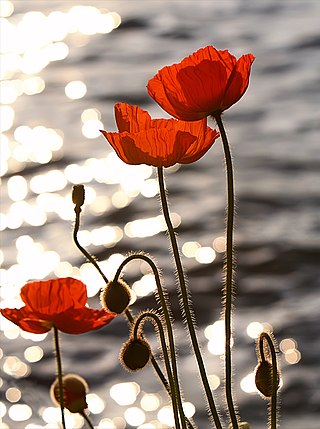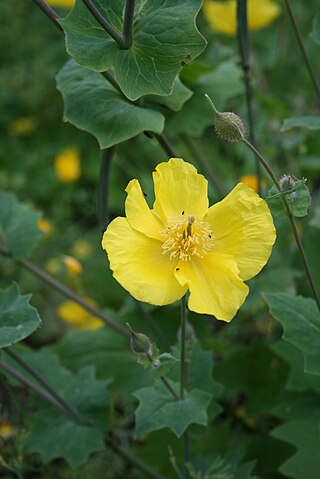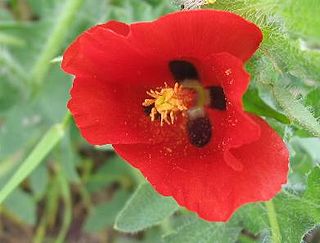
Eschscholzia californica, the California poppy, golden poppy, California sunlight or cup of gold, is a species of flowering plant in the family Papaveraceae, native to the United States and Mexico. It is cultivated as an ornamental plant flowering in summer, with showy cup-shaped flowers in brilliant shades of red, orange and yellow. It is also used as food or a garnish. It became the official state flower of California in 1903.

A poppy is a flowering plant in the subfamily Papaveroideae of the family Papaveraceae. Poppies are herbaceous plants, often grown for their colourful flowers. One species of poppy, Papaver somniferum, is the source of the narcotic drug mixture opium, which contains powerful medicinal alkaloids such as morphine and has been used since ancient times as an analgesic and narcotic medicinal and recreational drug. It also produces edible seeds. Following the trench warfare in the poppy fields of Flanders, Belgium, during World War I, poppies have become a symbol of remembrance of soldiers who have died during wartime, especially in the UK, Canada, Australia, New Zealand and other Commonwealth realms.

Crambe maritima, common name sea kale, seakale or crambe, is a species of halophytic (salt-tolerant) flowering plant in the genus Crambe of the family Brassicaceae. It grows wild along the coasts of mainland Europe and the British Isles.

The Papaveraceae, informally known as the poppy family, are an economically important family of about 42 genera and approximately 775 known species of flowering plants in the order Ranunculales. The family is cosmopolitan, occurring in temperate and subtropical climates like Eastern Asia as well as California in North America. It is almost unknown in the tropics. Most are herbaceous plants, but a few are shrubs and small trees. The family currently includes two groups that have been considered to be separate families: Fumariaceae and Pteridophyllaceae. Papaver is the classical name for poppy in Latin.

Papaver somniferum, commonly known as the opium poppy or breadseed poppy, is a species of flowering plant in the family Papaveraceae. It is the species of plant from which both opium and poppy seeds are derived and is also a valuable ornamental plant grown in gardens. Its native range was east of the Mediterranean Sea, but now is obscured by ancient introductions and cultivation, being naturalized across much of Europe and Asia.
NVC community SD1 is the only shingle community in the British National Vegetation Classification system.

Glaucium flavum, the yellow horned poppy, yellow hornpoppy or sea poppy, is a summer flowering plant in the family Papaveraceae. It is native to Europe, Northern Africa, Macaronesia and temperate zones in Western Asia. The plant grows on the seashore and is never found inland. All parts of the plant, including the seeds, are toxic. It is classed as a noxious weed in some areas of North America, where it is an introduced species. It is grown in gardens as a short-lived perennial but usually grown as a biennial.

Dicranostigma, also known as the eastern horned poppies, is a genus in the poppy family Papaveraceae, the species of which are native to the Himalaya and western China. Although resembling the true horned poppies of Glaucium, they have stigmas with two lobes and fruit with only traces of the "horns".

Glaucine(1,2,9,10-TetraMethoxyAporphine, Bromcholitin, Glauvent, Tusidil, Tussiglaucin) is an aporphine alkaloid found in several different plant species in the family Papaveraceae such as Glaucium flavum, Glaucium oxylobum and Corydalis yanhusuo, and in other plants like Croton lechleri in the family Euphorbiaceae.

Black Rock is an area of beach and promenade located to the west of Brighton Marina and south of Sussex Square in Kemptown in the city of Brighton and Hove. It is one of the terminus stations of the Volk's railway, hosts a 200-year-old living wall, designated as a local wildlife site and including ninety plants such as Euonymus japonicus, and has area of vegetated shingle on the beach, recreated using plants such as Crambe maritima, Glaucium flavum and Solanum dulcamara (bittersweet) under the guidance of horticulturalists at Kew’s Millennium Seed Bank.

Wingletang Down is a Site of Special Scientific Interest (SSSI) on the southern side of the island of St Agnes in the Isles of Scilly, England, UK, which is noted for its biological characteristics. The site is managed by the Isles of Scilly Wildlife Trust and is within the Isles of Scilly Heritage Coast and the Isles of Scilly Area of Outstanding Natural Beauty. It is the only site in Great Britain and Ireland for the small fern, least adder's–tongue. As of 11 September 2009 the SSSI was considered to be in ″unconditional recovering″ condition because European gorse and bramble are at unacceptable levels.
Flavum is a Latin word meaning "yellow". It is often used in taxonomy for species names typically in scientific names for animals and plants to refer to the flower colour or other aspect of the species.

Glaucium corniculatum, the blackspot hornpoppy or red horned-poppy, is a species of the genus Glaucium in the poppy family (Papaveraceae). It is an annual flowering plant, occurring in southern Europe, and grows up to 1 foot (30 cm) high. The stem and leaves are hairy, the capsule fruit is covered with stiff hair, the flower is red, with a black spot on the base of the tepal bract, which has a yellow margin around it. The flower appears from June until August.

Glaucium secmenii is a species of flowering plant in the horned poppy genus which is endemic to Turkey.

Glaucium grandiflorum, the great-flowered horned poppy, is a species of flowering plant in the horned poppy genus which is native to the Middle East.
Glaucium calycinum is a species of flowering plant in the horned poppy genus which is endemic to Iran.

Glaucium oxylobum, called Lotus sweetjuice, is a species of flowering plant in the horned poppy genus which is native to Afghanistan, Iran, Israel, Turkmenistan, and Uzbekistan. It was originally described by Pierre Edmond Boissier and Friedrich Alexander Buhse in 1860 in the 12th volume of the Nouveaux mémoires de la Société impériale des naturalistes de Moscou.
Glaucium cuneatum is a species of flowering plant in horned poppy genus which is native to Iraq.
















